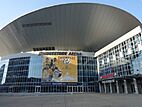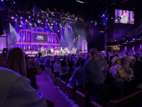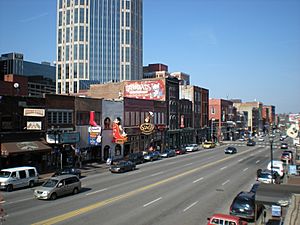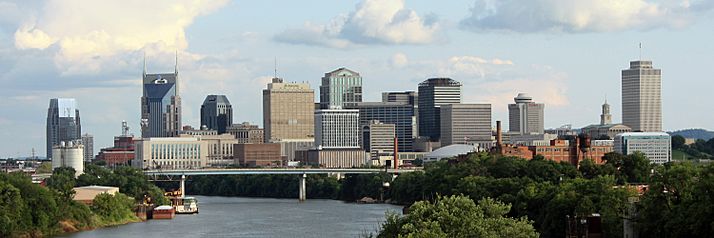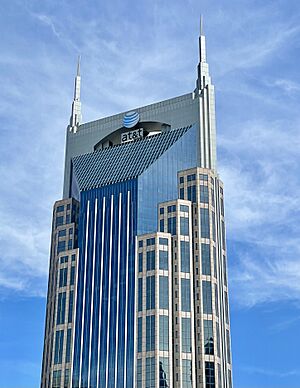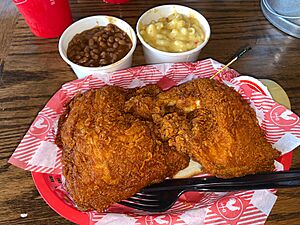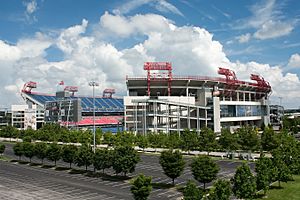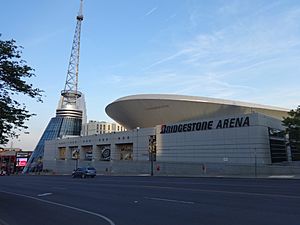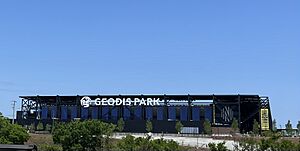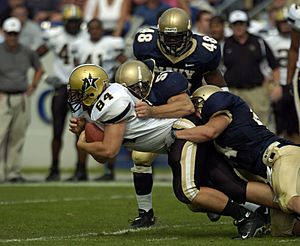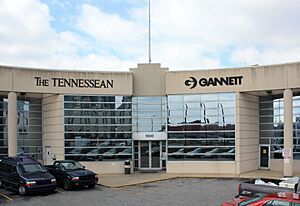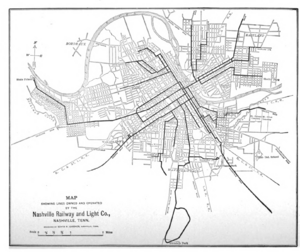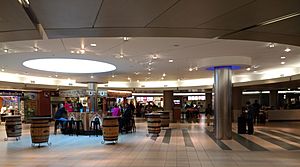Nashville, Tennessee facts for kids
Quick facts for kids
Nashville
|
|||
|---|---|---|---|
|
State capital and consolidated city-county
|
|||
| Metropolitan Government of Nashville and Davidson County | |||
|
|
|||
|
|||
| Nickname(s):
Music City, Country Music Capital, Athens of the South, Nashvegas
|
|||
| Country | |||
| State | Tennessee | ||
| County | Davidson | ||
| Founded | 1779 | ||
| Incorporated | 1806 | ||
| City-county consolidation | 1963 | ||
| Named for | Francis Nash | ||
| Area | |||
| • Consolidated | 525.94 sq mi (1,362.2 km2) | ||
| • Land | 504.03 sq mi (1,305.4 km2) | ||
| • Water | 21.91 sq mi (56.7 km2) | ||
| Elevation | 554 ft (169 m) | ||
| Population
(2022)
|
|||
| • Consolidated | 715,884 | ||
| • Rank | 69th in North America 21st in the United States 1st in Tennessee |
||
| • Density | 1,420.32/sq mi (548.39/km2) | ||
| • Urban | 1,158,642 (US: 42nd) | ||
| • Urban density | 1,980.7/sq mi (764.8/km2) | ||
| • Metro | 2,072,283 (US: 35th) | ||
| • Balance | 689,447 | ||
| Demonym(s) | Nashvillian | ||
| GDP | |||
| • Metro | 4.861 billion (2023) | ||
| Time zone | UTC−6 (CST) | ||
| • Summer (DST) | UTC−5 (CDT) | ||
| ZIP Codes |
37201-37222, 37224, 37227-37230, 37232, 37234-37236, 37238, 37240-37244, 37246, 37250
|
||
| Area codes | 615 and 629 | ||
| GNIS feature ID | 1652484 | ||
| Website | nashville.gov | ||
Nashville, often called Music City, is the capital and largest city in Tennessee. It is also the county seat of Davidson County. Located in Middle Tennessee, Nashville had a population of over 689,000 people in 2020. This makes it the 21st most populated city in the United States. It's also the fourth largest city in the southeastern U.S. Nashville sits on the Cumberland River and is one of the fastest growing cities in the country.
The city was named after Francis Nash, a general in the American Revolutionary War. It was founded in 1779 when this area was part of North Carolina. Nashville grew quickly because it was a great port on the Cumberland River. Later, it became a major railroad hub. During the American Civil War, Nashville was the first state capital in the South to be captured by Union forces in 1862. It remained under Union control for the rest of the war. After the war, Nashville became a strong center for trade and manufacturing.
Since 1963, Nashville has had a special "consolidated city-county" government. This means the city and county governments work together as one. It includes six smaller towns. The city is led by a mayor, a vice-mayor, and a 40-member council. Nashville is also home to the Tennessee Supreme Court for Middle Tennessee.
Today, Nashville is a "global city" and a huge center for the music industry, especially country music. It has three major professional sports teams: the Predators (hockey), Titans (football), and Nashville SC (soccer). Nashville is also home to many colleges and universities. These include Tennessee State University, Vanderbilt University, and Belmont University. Because of its many schools, Nashville is sometimes called the "Athens of the South." The city is also important for healthcare, publishing, banking, cars, and technology.
Contents
- Nashville's Story: A Look at Its History
- Nashville's Landscape: Geography and Climate
- Who Lives in Nashville: Demographics
- How Nashville Makes Money: Economy
- Nashville's Unique Culture
- Sports in Nashville
- Green Spaces: Parks and Gardens
- Learning in Nashville: Education
- News and Media in Nashville
- Getting Around Nashville: Infrastructure
- Nashville's Global Connections: International Relations
- See also
Nashville's Story: A Look at Its History
The town of Nashville was started by James Robertson and John Donelson in 1779. It was built near an older settlement called Fort Nashborough. The town was named after Francis Nash, a hero from the American Revolutionary War. Nashville quickly became important because it was a good port on the Cumberland River. This river connects to the Ohio River. Later, it became a big railroad center. By 1800, Nashville had 345 people. In 1806, Nashville officially became a city and the main town of Davidson County. In 1843, it was chosen as the permanent capital of Tennessee.
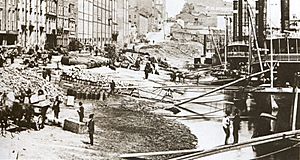
By 1860, Nashville was a busy and rich city. Its location as a shipping port made it a key target during the American Civil War. In February 1862, Nashville was the first state capital in the South to be taken by Union soldiers. It stayed under Union control for the rest of the war. The Battle of Nashville in December 1864 was a big win for the Union. It was one of the most important battles of the war.
After the Civil War, Nashville quickly rebuilt its trade and manufacturing. The late 1800s brought new wealth to the city. This led to many beautiful classical-style buildings being built downtown.
Nashville in the 20th Century
Around 1950, a new city plan was approved. This plan changed how city council members were elected. Before, they were elected by everyone in the city. This made it hard for minority groups to get their chosen leaders elected. The new plan allowed council members to be elected from smaller areas called "single-member districts." This meant some districts had a majority of African-American voters. In 1952, Z. Alexander Looby and Robert E. Lillard, who were African-American lawyers, were elected to the city council. They were the first to hold office since 1911.
After World War II, many people moved to new homes outside the city. This caused problems for the county, which struggled to build enough schools and services. At the same time, the city's tax money went down. Many people living in the suburbs still used city services but didn't pay city taxes. After many talks, a vote was held in 1958 to combine the city and county governments. It didn't pass.
So, Nashville added about 42 square miles of suburban areas to increase its tax base. This made some suburban communities unhappy. In 1962, a second plan for combining governments was approved. It created two service areas: the General Services District and the Urban Services District. People in the Urban Services District paid higher taxes for full city services. Those in the General Services District paid less until they received full services. This helped balance services and taxes across the larger area.
In 1963, Nashville and Davidson County officially combined their governments. The Metro Council, which makes laws, grew from 21 to 40 members. Five members are elected by everyone in the city, and 35 are elected from specific districts. Each serves a four-year term.
Since the 1970s, Nashville has grown a lot. This was especially true in the 1990s under Mayor Phil Bredesen. He focused on improving the city. Many famous places were built or fixed up, like the Country Music Hall of Fame and Museum and the Bridgestone Arena.
Nissan Stadium (formerly LP Field) was built after the National Football League (NFL) team, the Houston Oilers, decided to move to Nashville in 1995. The team played its first Nashville game in 1998. Nissan Stadium opened in 1999. The Oilers changed their name to the Tennessee Titans. They had a very exciting Super Bowl game in 1999, losing by just a little bit.
In 1997, Nashville also got a National Hockey League team, the Nashville Predators. Since the 2003-04 season, the Predators have made the playoffs almost every year.
Nashville in the 21st Century
Today, Nashville is a busy city along the Cumberland River. It's a mix of American cultures and one of the fastest-growing areas in the South.
The city recovered well from the Great Recession. In 2012, a poll said Nashville was one of the top five places for job growth. A TV show called Nashville also started that year. In 2013, the New York Times called Nashville a new "it" city.
Nashville's Landscape: Geography and Climate
What Nashville Looks Like: Topography
Nashville is located on the Cumberland River in the northwestern part of the Nashville Basin. The city's elevation changes from about 385 feet (117 meters) above sea level at the river to 1,160 feet (354 meters) at its highest point.
The city covers a total area of about 527.9 square miles (1,367.3 square kilometers). About 504.0 square miles (1,305.4 square kilometers) is land, and 23.9 square miles (61.9 square kilometers) is water.
Nashville's Weather: Climate Information
Nashville has a humid subtropical climate. This means it has hot, humid summers and usually mild winters. Average monthly temperatures range from about 37.7°F (3.2°C) in January to 79.4°F (26.3°C) in July.
Snow falls during winter, but it's usually not very heavy. On average, Nashville gets about 6.3 inches (16 cm) of snow each year. Most of it falls in January and February. The biggest snowfall since 2000 was 8 inches (20 cm) in January 2016.
Rainfall is usually higher in November, December, and spring. August to October are typically the driest months. Spring and fall can have strong thunderstorms. These sometimes bring tornadoes. Nashville's humidity is moderate for the southeastern U.S.
Because of city development, Nashville can be warmer in the city center than in the countryside. This is called an "urban heat island" effect. Nashville is in USDA Plant Hardiness Zone 7a.
Nashville's long springs and autumns, with many trees and grasses, can be tough for people with allergies. In 2008, Nashville was ranked the 18th worst city for spring allergies in the U.S.
The coldest temperature ever recorded in Nashville was -17°F (-27°C) in January 1985. The hottest was 109°F (43°C) in June 2012.
| Climate data for Nashville (Nashville Int'l), 1981–2010 normals, extremes 1871−present | |||||||||||||
|---|---|---|---|---|---|---|---|---|---|---|---|---|---|
| Month | Jan | Feb | Mar | Apr | May | Jun | Jul | Aug | Sep | Oct | Nov | Dec | Year |
| Record high °F (°C) | 78 (26) |
84 (29) |
89 (32) |
91 (33) |
96 (36) |
109 (43) |
107 (42) |
106 (41) |
105 (41) |
94 (34) |
88 (31) |
79 (26) |
109 (43) |
| Mean maximum °F (°C) | 68.0 (20.0) |
73.0 (22.8) |
80.2 (26.8) |
85.1 (29.5) |
88.7 (31.5) |
94.2 (34.6) |
97.1 (36.2) |
96.5 (35.8) |
93.0 (33.9) |
85.5 (29.7) |
77.7 (25.4) |
68.5 (20.3) |
98.3 (36.8) |
| Mean daily maximum °F (°C) | 46.9 (8.3) |
51.8 (11.0) |
61.0 (16.1) |
70.5 (21.4) |
78.2 (25.7) |
86.0 (30.0) |
89.3 (31.8) |
89.0 (31.7) |
82.4 (28.0) |
71.7 (22.1) |
60.3 (15.7) |
49.5 (9.7) |
69.7 (20.9) |
| Mean daily minimum °F (°C) | 28.4 (−2.0) |
31.6 (−0.2) |
39.0 (3.9) |
47.5 (8.6) |
56.8 (13.8) |
65.4 (18.6) |
69.5 (20.8) |
68.4 (20.2) |
60.7 (15.9) |
48.9 (9.4) |
39.4 (4.1) |
31.3 (−0.4) |
48.9 (9.4) |
| Mean minimum °F (°C) | 8.8 (−12.9) |
13.5 (−10.3) |
22.5 (−5.3) |
31.2 (−0.4) |
42.7 (5.9) |
54.3 (12.4) |
61.6 (16.4) |
59.4 (15.2) |
45.4 (7.4) |
32.7 (0.4) |
23.8 (−4.6) |
13.8 (−10.1) |
4.7 (−15.2) |
| Record low °F (°C) | −17 (−27) |
−13 (−25) |
2 (−17) |
23 (−5) |
34 (1) |
42 (6) |
51 (11) |
47 (8) |
36 (2) |
26 (−3) |
−1 (−18) |
−10 (−23) |
−17 (−27) |
| Average precipitation inches (mm) | 3.75 (95) |
3.94 (100) |
4.11 (104) |
4.00 (102) |
5.50 (140) |
4.14 (105) |
3.64 (92) |
3.17 (81) |
3.41 (87) |
3.04 (77) |
4.31 (109) |
4.24 (108) |
47.25 (1,200) |
| Average snowfall inches (cm) | 2.6 (6.6) |
2.3 (5.8) |
0.9 (2.3) |
0 (0) |
0 (0) |
0 (0) |
0 (0) |
0 (0) |
0 (0) |
trace | 0 (0) |
0.5 (1.3) |
6.3 (16) |
| Average precipitation days (≥ 0.01 in) | 10.3 | 10.3 | 10.7 | 10.8 | 11.7 | 10.0 | 10.2 | 8.4 | 7.5 | 8.0 | 9.8 | 11.2 | 118.9 |
| Average snowy days (≥ 0.1 in) | 2.1 | 2.3 | 0.7 | 0 | 0 | 0 | 0 | 0 | 0 | 0.1 | 0 | 1.0 | 6.2 |
| Average relative humidity (%) | 70.4 | 68.5 | 64.6 | 63.2 | 69.5 | 70.4 | 72.8 | 73.1 | 73.7 | 69.4 | 70.2 | 71.4 | 69.8 |
| Mean monthly sunshine hours | 139.6 | 145.2 | 191.3 | 231.5 | 261.8 | 277.7 | 279.0 | 262.1 | 226.4 | 216.8 | 148.1 | 130.6 | 2,510.1 |
| Percent possible sunshine | 45 | 48 | 52 | 59 | 60 | 64 | 63 | 63 | 61 | 62 | 48 | 43 | 56 |
| Source: NOAA (relative humidity and sun 1961−1990), Weather.com | |||||||||||||
City Views: Nashville's Cityscape
Downtown Nashville offers many fun things to do. You can find entertainment, restaurants, and cool buildings. The Broadway and 2nd Avenue areas have lots of music venues and nightclubs. North of Broadway are the main business district and the Tennessee Bicentennial Mall.
Three major highways (I-40, I-65, and I-24) meet near downtown. This makes it easy to drive to many nearby cities.
Nashville's first tall building, the Life & Casualty Tower, was built in 1957. This started a trend of building more tall buildings downtown. After the AT&T Building (also known as the "Batman Building") was finished in 1994, not much new construction happened until the mid-2000s. Since then, many new homes and offices have been built or are planned. The Pinnacle, a tall office building, opened in 2010.
Many city projects have been completed or are being planned. A new bus station was recently finished downtown. The Music City Center, a large convention center, opened in May 2013. It has 1,200,000 square feet (110,000 m2) of space.
Nashville's Areas: Neighborhoods
- Antioch
- Bellevue
- Cane Ridge
- Donelson
- East Nashville
- Germantown
- Green Hills
- The Gulch
- Hermitage
- Hillsboro Village
- Inglewood
- Joelton
- Lakewood
- Lockeland Springs
- Madison
- Old Hickory
- Pasquo
- Tusculum
- Whites Creek
Who Lives in Nashville: Demographics
| Historical population | |||
|---|---|---|---|
| Census | Pop. | %± | |
| 1810 | 1,100 | — | |
| 1820 | 3,410 | 210.0% | |
| 1830 | 5,566 | 63.2% | |
| 1840 | 6,929 | 24.5% | |
| 1850 | 10,165 | 46.7% | |
| 1860 | 16,988 | 67.1% | |
| 1870 | 25,865 | 52.3% | |
| 1880 | 43,350 | 67.6% | |
| 1890 | 76,168 | 75.7% | |
| 1900 | 80,865 | 6.2% | |
| 1910 | 110,364 | 36.5% | |
| 1920 | 118,342 | 7.2% | |
| 1930 | 153,866 | 30.0% | |
| 1940 | 167,402 | 8.8% | |
| 1950 | 174,307 | 4.1% | |
| 1960 | 170,874 | −2.0% | |
| 1970 | 448,003 | 162.2% | |
| 1980 | 455,651 | 1.7% | |
| 1990 | 488,374 | 7.2% | |
| 2000 | 545,524 | 11.7% | |
| 2010 | 601,222 | 10.2% | |
| 2020 | 689,447 | 14.7% | |
| 2023 (est.) | 687,788 | 14.4% | |
| Sources: Notes: |
|||
| Historical racial composition | 2020 | 2010 | 1990 | 1980 | 1970 |
|---|---|---|---|---|---|
| White (Non-Hispanic) | 53.3% | 56.3% | 73.2% | 75.2% | 79.5% |
| Black or African American (Non-Hispanic) | 24.3% | 28.2% | 24.3% | 23.3% | 19.6% |
| Hispanic or Latino | 14.0% | 10.0% | 0.9% | 0.8% | 0.6% |
| Asian | 3.9% | 3.1% | 1.4% | 0.5% | 0.1% |
| Mixed | 3.8% | 1.9% | |||
| American Indian and Alaska Native | 0.2% | 0.2% | 0.8% | 0.2% | 0.1% |
| Native Hawaiian and Other Pacific Islander | 0.1% | 0.0% | 0.1% | N/A | N/A |
| Other Race | 0.5% |
In 2020, Nashville had 689,447 people. This was a big increase of over 88,000 people since 2010. The city had 279,545 households.
In 2010, the average household had 2.38 people. The average family had 3.16 people. About 22.2% of the population was under 18 years old. The median age was 34.2 years.
The median income for a household in Nashville was $46,141. For a family, it was $56,377. About 18.2% of the population lived below the poverty line. This included 29.5% of those under 18.
Nashville has become a popular city for immigrants. This is because of its lower cost of living and many job opportunities. Between 1990 and 2000, the number of foreign-born people in Nashville tripled. The largest immigrant groups include Mexicans, Kurds, and Vietnamese. Nashville has the largest Kurdish community in the United States, with about 15,000 people.
In 1779, about 20% of the settlers in Fort Nashborough were enslaved or free African Americans. Over time, the African American community in Nashville grew. They built schools, churches, and businesses. These helped the city develop and progress.
Nashville's Larger Area: Metropolitan Area
As of 2020, Nashville has the largest metropolitan area in Tennessee. It has a population of over 2 million people. The Nashville metropolitan area includes 13 counties in Middle Tennessee.
Beliefs and Faith: Religion in Nashville
About 59.6% of people in Nashville say they have a religious connection. The main religion is Christianity, followed by 57.7% of the population. This includes different Christian groups like Baptists, Catholics, and Methodists. Islam is the second largest religion, with 0.8% of the population. Other religions like Buddhism, Sikhism, and Hinduism are followed by 0.6%. About 0.3% of the population follows Judaism.
How Nashville Makes Money: Economy
In the 2010s, many reports called Nashville a "southern boomtown." In 2017, it had the third-fastest growing economy among U.S. cities. It was said to add about 100 people to its population every day. Nashville was also named the "Number One" city for professional and business jobs. In 2013, Forbes magazine listed Nashville as one of the best places for business and careers. In 2015, it was ranked the fourth best city for white-collar jobs.
Many large companies have offices in Nashville. These include Bridgestone Americas and Nissan North America. Some companies are even headquartered here, like Dollar General and Hospital Corporation of America (HCA Healthcare). Many popular food companies are also based in Nashville, such as Captain D's.
Nashville is known as the "home of country music." It's a major center for recording and producing music. The biggest record labels have offices in Nashville. Most are in the Music Row area. Gibson, a famous guitar company, has been based in Nashville since 1984. Since the 1960s, Nashville has been the second-largest music production center in the U.S., after New York City. The music industry in Nashville brings in about $10 billion each year. It also provides about 56,000 jobs.
The largest industry in the area is healthcare. Nashville is home to over 300 healthcare companies. This includes Hospital Corporation of America (HCA), which is the world's largest private hospital operator. In 2012, the healthcare industry was estimated to bring in $30 billion per year. It also created 200,000 jobs in the Nashville area.
The car industry is also growing in Middle Tennessee. Nissan North America moved its main office to Franklin, a suburb of Nashville, in 2006. Nissan's biggest North American factory is in Smyrna, another Nashville suburb. General Motors has a factory in Spring Hill, about 35 miles (56 km) south of Nashville.
Other important industries in Nashville include insurance, finance, and publishing. Many Protestant religious groups have their main offices in the city. These include the United Methodist Church and the Southern Baptist Convention.
Nashville is also famous for its Southern sweets. Goo Goo Clusters, a type of candy, have been made in Nashville since 1912.
In 2018, AllianceBernstein decided to move its headquarters from New York City to Nashville by 2024. In 2021, Oracle Corporation announced plans for a $1.2 billion campus in Nashville. It is expected to create 8,500 jobs by 2031. In 2019, iHeartMedia chose Nashville for its second digital headquarters.
Real estate is also a big part of Nashville's economy. In 2016, Nashville was ranked seventh in the country for attracting real estate investors. Over $2 billion in real estate projects were underway or planned for 2016. The city has changed its zoning rules to make it easier to build mixed-use projects. These combine homes, offices, shops, and entertainment. The city has also invested a lot in public parks. This helps make Nashville a more walkable and appealing city.
Top Employers in Nashville
Here are the top employers in Nashville:
| # | Employer | Employees |
|---|---|---|
| 1 | Vanderbilt University Medical Center | 28,300 |
| 2 | State of Tennessee | 26,733 |
| 3 | U.S. federal government | 13,707 |
| 4 | HCA Healthcare | 10,600 |
| 5 | Metropolitan Nashville Public Schools | 10,281 |
| 6 | Vanderbilt University | 8,822 |
| 7 | Metropolitan Government of Nashville and Davidson County | 8,700 |
| 8 | Ascension Saint Thomas | 8,335 |
| 9 | The Kroger Co. | 7,813 |
| 10 | Amazon | 5,000 |
| 11 | Asurion | 4,260 |
| 12 | Bridgestone Americas Inc. | 4,110 |
Nashville's Unique Culture
Much of Nashville's culture comes from its many universities. Two important groups of writers and critics from Vanderbilt University in the early 1900s were the Fugitives and the Agrarians.
Popular places to visit include Fort Nashborough, a rebuilt early settlement, and Fort Negley, a Civil War fort. You can also visit the Tennessee State Museum and The Parthenon. The Parthenon is a full-size copy of the famous Greek Parthenon in Athens. The Tennessee State Capitol is one of the oldest working state capitol buildings in the country. The Hermitage, the former home of President Andrew Jackson, is one of the largest presidential homes open to the public.
What to Eat: Dining in Nashville
Some popular local foods include hot chicken, hot fish, barbecue, and "meat and three." "Meat and three" means you pick one meat and three side dishes.
Music and Shows: Entertainment and Performing Arts
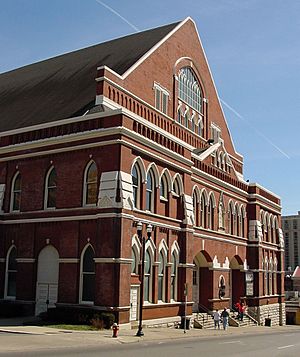
Nashville has a lively music and entertainment scene with many different types of music. It's called 'Music City' for a good reason! The Tennessee Performing Arts Center is the main place for performing arts. It's home to the Nashville Repertory Theatre and the Nashville Ballet. In 2006, the Schermerhorn Symphony Center opened as the home of the Nashville Symphony.
Since Nashville is known for country music, many popular places are about this type of music. These include the Country Music Hall of Fame and Museum and the Ryman Auditorium. The Ryman was home to the Grand Ole Opry until 1974. The Opry then moved to the Grand Ole Opry House. The Opry still performs there several times a week, except for a winter season at the Ryman.
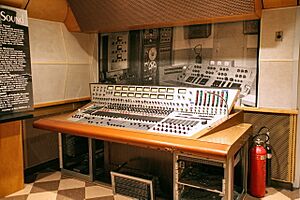
Many music clubs and honky-tonk bars are in downtown Nashville. This area is often called "the District."
Every June, the CMA Music Festival brings thousands of country music fans to the city. The Tennessee State Fair is also held every September.
Nashville was once home to TV shows like Hee Haw. Country Music Television and Great American Country still operate from Nashville. The city also had the Opryland USA theme park from 1972 to 1997. It was later replaced by the Opry Mills shopping mall.
The Contemporary Christian music industry is also big in Nashville. Christian record companies like EMI Christian Music Group are based here.
Nashville has an active theatre scene. It's home to several professional and community theatre groups. The Barbershop Harmony Society also has its main office in Nashville.
Visiting Nashville: Tourism
One of the biggest reasons people visit Nashville is its connection to country music. Many visitors go to live performances of the Grand Ole Opry. This is the world's longest-running live radio show. The Country Music Hall of Fame and Museum is another popular spot for country music fans. The Gaylord Opryland Resort & Convention Center and the Opry Mills mall are also in the Music Valley area.
Civil War history is also a big draw for tourists. You can visit sites from the Battle of Nashville and nearby battles. There are also well-preserved old plantation houses like Belle Meade Plantation.
Nashville has many art centers and museums. These include the Frist Center for the Visual Arts and the Tennessee State Museum. You can also see the full-scale replica of the Parthenon. Inside, a sculpture of Athena Parthenos is the tallest indoor sculpture in the Western World, standing 42 feet high.
Nashville has become a very popular place for bachelor and bachelorette parties. The downtown area has many bars with live music and no cover charge. In 2018, The New York Times called Nashville "the hottest destination for bachelorette parties."
Big Events Each Year: Major Annual Events
| Event | Month held and location |
|---|---|
| Nashville Film Festival | A weeklong festival in April that shows hundreds of independent films. It's one of the largest film festivals in the Southern United States. |
| Nashville Fashion Week | A citywide event usually in March or April. It celebrates Nashville's fashion and retail community. It features local and national designers in fashion shows. |
| Rock 'n' Roll Nashville Marathon | A marathon, half marathon, and 5k race held in April. Runners come from all over the world. In 2012, over 30,000 runners took part. |
| Rites of Spring Music Festival | A two-day music festival held every April at Vanderbilt University since 1986. Many famous artists have performed here. |
| Iroquois Steeplechase | An annual horse racing event held in May at Percy Warner Park. |
| CMA Music Festival | A four-day event in June with performances by country music stars. It includes autograph signings and other activities for fans. |
| Nashville Pride | A two-day event in June that promotes awareness for the LGBT community in Middle Tennessee. The 2019 festival had over 75,000 people. |
| Let Freedom Sing! | Held every Fourth of July at Riverfront Park. It has a street festival, live music, and one of the largest fireworks shows in the country. |
| Tomato Art Festival | Held each August in East Nashville. This event celebrates the Tomato as a Unifier. |
| African Street Festival | Held in September at Tennessee State University. It connects and celebrates African and American cultures. |
| Live on the Green Music Festival | A free concert series held in August and September at Public Square Park. It's put on by local radio station Lightning 100. |
| Tennessee State Fair | The State Fair held in September at the State Fairgrounds. It lasts nine days and has rides, exhibits, and shows. |
| Celebrate Nashville Cultural Festival | A free event held the first Saturday in October at Centennial Park. It's Middle Tennessee's largest multicultural festival. It includes music, dance, food, and a marketplace. |
| Art Nashville International Art Fair | An annual Art Fair in downtown Nashville. It features galleries and dealers from around the world. |
| Nashville Oktoberfest | A free event held in the historic Germantown neighborhood since 1980. It celebrates German culture and customs. It's Nashville's oldest annual festival. |
| Southern Festival of Books | A festival held in October with readings, discussions, and book signings. |
| Country Music Association Awards | An award ceremony usually held in November at the Bridgestone Arena. It is shown on TV to a national audience. |
| Veterans Day Parade | A parade down Broadway on November 11 at 11:11 AM since 1951. It features military groups, veterans, and marching bands. |
What Nashville is Called: Nicknames
Nashville has many nicknames because it's famous in different ways:
- Music City, U.S.A.: A radio announcer first used this name in 1950, and it stuck. It's now the official nickname. Nashville is home to the Grand Ole Opry and the Country Music Hall of Fame. This name also comes from 1874. After hearing the Fisk Jubilee Singers, Queen Victoria of England reportedly said, "These young people must surely come from a musical city."
- Athens of the South: Nashville has 24 colleges and universities. It has long been compared to Athens, an ancient city known for learning. Since 1897, a full-size copy of the Athenian Parthenon has stood in Nashville. Many classical buildings are also in the city.
- The Protestant Vatican or The Buckle of the Bible Belt: Nashville has over 700 churches and many Christian music companies. It is the headquarters for several Protestant groups.
- Cashville: Nashville-born rapper Young Buck released a popular album called Straight Outta Cashville. This made the nickname popular with a new generation.
- Little Kurdistan: Nashville has the largest population of Kurdish people in the United States, estimated at around 11,000.
- Nash Vegas or Nashvegas
Nashville is also known as "The Hot Chicken Capital." This is because of its local spicy fried chicken dish called hot chicken. The Music City Hot Chicken Festival is held every year in Nashville.
Sports in Nashville
Professional Sports Teams
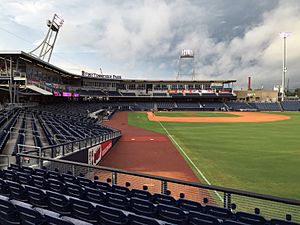
Nashville is home to four professional sports teams. Three of them play at the highest professional level:
- The Tennessee Titans in the National Football League (NFL).
- The Nashville Predators in the National Hockey League (NHL).
- Nashville SC in Major League Soccer (MLS).
The city also has one minor league team:
| Team | Sport | League | Venue | Founded |
|---|---|---|---|---|
| Tennessee Titans | Football | National Football League | Nissan Stadium | 1959/1997 |
| Nashville Predators | Hockey | National Hockey League | Bridgestone Arena | 1997 |
| Nashville Sounds | Baseball | International League | First Horizon Park | 1978 |
| Nashville SC | Soccer | Major League Soccer | Geodis Park | 2020 |
The Tennessee Titans football team moved to Nashville in 1998. They were previously the Houston Oilers. They played in Memphis for one season, then in Nashville at Vanderbilt Stadium for one season. In 1999, they changed their name to the Titans. They now play at Nissan Stadium. Since moving to Nashville, the Titans have won five division championships and one conference championship. They played in the 1999 Super Bowl XXXIV, losing a very close game.
The Nashville Predators hockey team joined the National Hockey League in the 1998–99 season. They play their home games at Bridgestone Arena. The Predators have won two division championships and one conference championship.
Nashville SC, a Major League Soccer team, started playing in 2020 at Nissan Stadium. They moved to their new soccer-specific stadium, Geodis Park, in 2022.
The Nashville Sounds baseball team started in 1978. They won league championships in 1979 and 1982. In 1985, they became a Triple-A team. The Sounds moved to First Horizon Park in 2015. They have won eleven division titles and three league championships.
Nashville is also home to the Fairgrounds Speedway. It's the second-oldest continuously running racetrack in the U.S. It used to host NASCAR races. The Nashville Superspeedway is about 30 miles (48 km) southeast of Nashville. It reopened in 2021 and hosts the top NASCAR Cup Series race.
College and Amateur Sports
Nashville has four Division I college sports programs. It also hosts the NCAA college football Music City Bowl.
| Program | Division | Conference |
|---|---|---|
| Vanderbilt Commodores | Division I (FBS) | Southeastern Conference |
| Tennessee State Tigers | Division I (FCS) | Ohio Valley Conference |
| Belmont Bruins | Division I (non-football) | Missouri Valley Conference |
| Lipscomb Bisons | Division I (non-football) | ASUN Conference |
The Nashville Rollergirls are Nashville's only women's flat track roller derby team. They compete regionally and nationally. The Nashville Kangaroos are an Australian Rules Football team.
Three Little League Baseball teams from Nashville have made it to the Little League World Series. Teams from nearby Goodlettsville also qualified in 2012 and 2016.
Green Spaces: Parks and Gardens
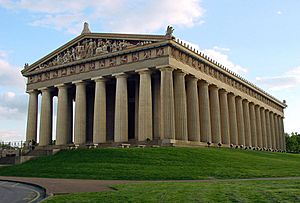
The Metro Board of Parks and Recreation manages over 10,200 acres (4,100 ha) of land. This includes 99 parks and greenways.
Warner Parks covers 2,684 acres (1,086 ha). It has a large learning center, 20 miles (32 km) of scenic roads, 12 miles (19 km) of hiking trails, and 10 miles (16 km) of horse trails. It also hosts the annual Iroquois Steeplechase.
The United States Army Corps of Engineers maintains parks on Old Hickory Lake and Percy Priest Lake. These parks are great for fishing, water skiing, and boating.
Other parks in Nashville include Centennial Park, Shelby Park, Cumberland Park, and Radnor Lake State Natural Area.
In 2013, Nashville's mayor announced plans for two new riverfront parks downtown. One will include a new outdoor amphitheater for concerts. This venue will hold 6,500 people. The other park will give people access to the river.
Learning in Nashville: Education
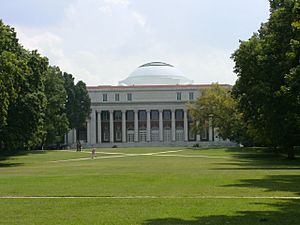
Nashville's public schools are managed by Metropolitan Nashville Public Schools, also known as Metro Schools. This is the second largest school district in Tennessee. It has about 85,000 students in 169 schools. Nashville also has many private schools. These include Montgomery Bell Academy and Harpeth Hall School. Over 15,000 students attend private schools in Nashville.
Colleges and Universities in Nashville

Nashville is called the "Athens of the South" because it has so many colleges and universities. About 43,000 students are enrolled in higher education in Nashville.
The largest school is Vanderbilt University, with about 13,000 students. Vanderbilt is a top research university. It is known for its medical, law, and education programs.
Nashville has more historically Black universities than any city except Atlanta. These include Fisk University, Tennessee State University, and Meharry Medical College.
Other schools in Nashville include Belmont University and Lipscomb University. The Tennessee Board of Regents also runs Nashville State Community College.
Nearby cities also have colleges. These include Middle Tennessee State University (MTSU) in Murfreesboro and Austin Peay University in Clarksville.
News and Media in Nashville
Nashville's daily newspaper is The Tennessean. It is the most widely read newspaper in the city. The online news service NashvillePost.com also reports on local and state news. Several weekly papers are published in Nashville. These include The Nashville Business Journal and Nashville Scene.
Nashville has eleven broadcast television stations. Most homes get their TV through cable. Nashville is the 26th largest television market in the United States. Major stations include WKRN-TV (ABC), WSMV-TV (NBC), and WTVF (CBS).
Nashville is also home to cable channels like Country Music Television (CMT) and RFD-TV.
Many radio stations broadcast in the Nashville area. WSM-AM is famous for broadcasting the Grand Ole Opry live. This helped make country music popular across America.
Several major movies have been filmed in Nashville. These include The Green Mile and Coal Miner's Daughter. The ABC television series Nashville was also filmed here.
Getting Around Nashville: Infrastructure
How People Travel: Transportation
In 2016, most working Nashville residents (78.1%) drove alone to work. About 9.8% carpooled. Only 2% used public transportation. About 6.7% of people worked from home. In 2016, Nashville households had an average of 1.72 cars.
Roads and Highways
Nashville is located where three major Interstate Highways meet. These are I-40 (east-west), I-24 (northwest-southeast), and I-65 (north-south). These highways connect Nashville to other big cities like Memphis, Knoxville, and Louisville. All three interstates go around downtown Nashville.
I-440 is a bypass road south of downtown. Briley Parkway is a freeway that goes around the north side of the city. Many U.S. Routes also serve Nashville. Most of these roads are called "pikes" and are named after towns they lead to.
Buses and Trains: Public Transit
WeGo Public Transit provides bus service in Nashville. The bus routes mostly start from the Music City Central station downtown. A new plan was passed in 2024 to improve sidewalks, add smart traffic signals, and upgrade bus stops. It also includes 24-hour bus service and new high-capacity transit routes.
Nashville is an important city for train and air travel in the southeastern U.S.
Flying In: Air Travel
The city is served by Nashville International Airport (BNA). It is run by the Metropolitan Nashville Airport Authority. In 2023, nearly 23 million passengers used the airport. This makes it the 29th busiest airport in the U.S. BNA is also the fastest growing airport among the top 50 in the United States. It has about 600 daily flights to over 100 different places.
In 2014, BNA was the first major U.S. airport to have special pick-up and drop-off areas for ride-sharing companies.
The airport authority also runs the John C. Tune Airport, which is for smaller, private planes.
Trains for People: Intercity Rail
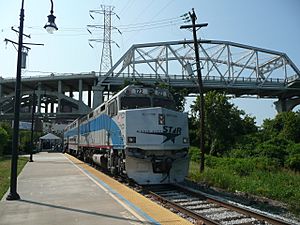
Even though Nashville is a big freight hub for trains, it doesn't currently have passenger train service from Amtrak. Nashville's Union Station used to be a major passenger train center. However, service ended in 1979.
People have asked for Amtrak service to return to Nashville. But state officials think Nashville isn't big enough to support it. In 2020, Amtrak said it was thinking about a train service from Atlanta to Nashville.
Nashville started a commuter train system called the Music City Star (now the WeGo Star) in 2006. Currently, it connects the city of Lebanon to downtown Nashville. Plans for more routes to other suburbs are being studied.
Crossing Rivers: Bridges
Here are some of the bridges in Nashville:
| Official name | Other names | Length | Date opened | Notes |
|---|---|---|---|---|
| Korean War Veterans Memorial Bridge | Gateway Bridge | 1,660 ft (506 m) | May 19, 2004 | |
| Kelly Miller Smith Memorial Bridge | Jefferson Street Bridge | 1,835 ft (559 m) | March 2, 1994 | |
| Old Hickory Bridge | 1,222 ft (372 m) | 1928; second span built 1967 | ||
| Martin Luther King Jr. Bridge | Bordeaux Bridge | September 18, 1980 | ||
| John Seigenthaler Pedestrian Bridge | Shelby Street Bridge | 3,150 ft (960 m) | July 5, 1909 | |
| Silliman Evans Bridge | 2,362 ft (720 m) | January 14, 1964 | ||
| Lyle H. Fulton Memorial Bridge |
March 15, 1971 |
|||
| Victory Memorial Bridge | May 19, 1956 | |||
| William Goodwin Bridge | Hobson Pike Bridge | 2,215 ft (675 m) | ||
| Woodland Street Bridge | 639 ft (195 m) | April 10, 1886; replaced 1965 |
City Services: Utilities
Nashville owns its own electric company, Nashville Electric Service (NES). It also owns Metro Water Services (MWS) and the Nashville District Energy System (NDES). NES provides electricity to Davidson County and parts of nearby counties. MWS provides water, wastewater, and stormwater services. It gets water from the Cumberland River. Natural gas is provided by Piedmont Natural Gas.
Staying Healthy: Healthcare
As a major healthcare center, Nashville has several hospitals and clinics. Most hospitals are run by Vanderbilt University Medical Center, TriStar Division of Hospital Corporation of America, and Ascension Saint Thomas. The city also operates Nashville General Hospital, which works with Meharry Medical College.
Nashville's Global Connections: International Relations
Sister Cities Around the World
Nashville has "sister cities" in different countries. These partnerships help build cultural and economic ties:
- Candidates
- International Friendship City
 Crouy, France
Crouy, France
- Municipality United in Friendship
 El Port de la Selva, Spain
El Port de la Selva, Spain
Foreign Offices: Consulates
Nashville is also home to consulates for these countries:
See also
 In Spanish: Nashville para niños
In Spanish: Nashville para niños






